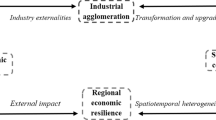Abstract
The problems with China’s regional industrial overcapacity are often influenced by local governments. This study constructs a framework that includes the resource and environmental costs to analyze overcapacity using the non-radial direction distance function and the price method to measure industrial capacity utilization and market segmentation in 29 provinces in China from 2002 to 2014. The empirical analysis of the spatial panel econometric model shows that (1) the industrial capacity utilization in China’s provinces has a ladder-type distribution with a gradual decrease from east to west and there is a severe overcapacity in the traditional heavy industry areas; (2) local government intervention has serious negative effects on regional industry utilization and factor market segmentation more significantly inhibits the utilization rate of regional industry than commodity market segmentation; (3) economic openness improves the utilization rate of industrial capacity while the internet penetration rate and regional environmental management investment have no significant impact; and(4) a higher degree of openness and active private economic development have a positive spatial spillover effect, while there is a significant negative spatial spillover effect from local government intervention and industrial structure sophistication. This paper includes the impact of resources and the environment in overcapacity evaluations, which should guide sustainable development in emerging economies.




Similar content being viewed by others
References
Barham B, Ware R (1993) A sequential entry model with strategic use of excess capacity. Can J Econ 26:286–298
Elhorst JP (2010) Applied spatial econometrics: raising the bar. Spat Econ Anal 5:9–28
Gan C, Zou J, Wang J (2015) Term of local officials, enterprise resource acquisition and excess capacity. China Ind Econ 3:44–56
Gui Q, Chen M, Lu M et al (2006) Whether China’s domestic commodity markets tend to segmentation or consolidation: based on the analysis of the relative price method. J World Econ 29:20–30
Gunasekaran A, Jabbour CJC, Jabbour ABLDS (2014) Managing organizations for sustainable development in emerging countries: an introduction. Int J Sust Dev World 21:195–197
Jabbour ABLS, Jabbour CJC, Sarkis J, Govindan K (2014) Brazil’s new national policy on solid waste: challenges and opportunities. Clean Techn Environ 16:7–9
Jiang F, Geng Q, Lyu DG, Li XP (2012) Mechanism of excess capacity based on China’s regional competition and market distortion. China Ind Econ 6:44–56
Jin P, Zhang Y, Deng M (2015) The analysis of spatial-temporal evolution and the relationship between regional factor market segmentation and factors allocation efficiency. Geogr Res 34:953–966
Kirkley J, Paul CJM, Squires D (2002) Capacity and capacity utilization in common-pool resource industries. Environ Resour Econ 22:71–97
Lin Y, Wu H, Xing Y (2010) “Wave phenomena” and formation of excess capacity. Econ Res 10:19–19
Lu M, Chen Z (2009) Fragmented growth: why economic opening may worsen domestic market segmentation. Econ Res J 3:42–52
Marcelino RBP, Queiroz MTA, Amorim CC, Leão MMD, Brites-Nóbrega FF (2015) Solar energy for wastewater treatment: review of international technologies and their applicability in Brazil. Environ Sci Pollut Res 22:762–773
Paha J (2013) Cartel formation with endogenous capacity and demand uncertainty. Joint Discussion Paper Series in Economics, No. 43-2013
Parsley DC, Wei S-J (2001) Limiting currency volatility to stimulate goods market integration: a price based approach. NBER Working Paper No.8468
Poncet S (2003) Measuring Chinese domestic and international integration. China Econ Rev 14:1–21
Qian Y, Roland G (1998) Federalism and the soft budget constraint. Am Econ Rev 88:1143–1162
Rosano-Peña C, Guarnieri P, Sobreiro VA, Serrano ALM, Kimura H (2014) A measure of sustainability of Brazilian agribusiness using directional distance functions and data envelopment analysis. Int J Sust Dev World 21:210–222
Sahoo BK, Tone K (2009) Decomposing capacity utilization in data envelopment analysis: an application to banks in India. Eur J Oper Res 195:575–594
Santana NB, do Nascimento A, Rebelatto D, Périco AE, Mariano EB (2014) Sustainable development in the BRICS countries: an efficiency analysis by data envelopment. Int J Sust Dev World 21:259–272
Shahbaz M, Farhani S, Ozturk I (2015) Do coal consumption and industrial development increase environmental degradation in China and India? Environ Sci Pollut Res 22:3895–3907
Song M, Jin P (2016) Regional protection, resource misallocation and environment welfare performance. Econ Res J 12:47–61
Segerson K, Squires D (1993) Capacity utilization under regulatory constraints. Rev Econ Stat 75:76–85
Spence AM (1977) Entry, capacity, investment and oligopolistic pricing. Bell J Econ 8:534–544
Stiglitz JE (1999) Toward a general theory of wage and price rigidities and economic fluctuations. Am Econ Rev 89:75–80
Wu Y (2016) China’s capital stock series by region and sector. Front Econ China 11:156
Young A (2000) The razor’s edge: distortions and incremental reform in the People’s Republic of China. Q J Econ 115:1091–1135
Zhang N, Choi Y (2013) A comparative study of dynamic changes in CO2 emission performance of fossil fuel power plants in China and Korea. Energy Pol 62:324–332
Acknowledgements
This work was supported by the National Natural Science Foundation of China (Grant Nos. 71471001 and 71533004) and the Program for Projects in Philosophy and Social Science Research of the Ministry of Education of China (Grant No. 14JZD031).
Author information
Authors and Affiliations
Corresponding author
Additional information
Responsible editor: Philippe Garrigues
Rights and permissions
About this article
Cite this article
Jiang, Z., Jin, P., Mishra, N. et al. Market segmentation and industry overcapacity considering input resources and environmental costs through the lens of governmental intervention. Environ Sci Pollut Res 24, 21351–21360 (2017). https://doi.org/10.1007/s11356-017-9639-4
Received:
Accepted:
Published:
Issue Date:
DOI: https://doi.org/10.1007/s11356-017-9639-4




